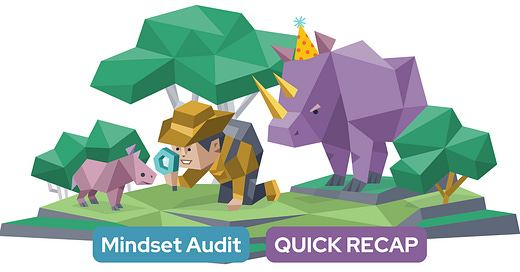Life gets busy. If the 5-Day Mindset Audit slipped through the cracks, I’ve gathered the essentials so you can still lead with clarity and focus.
First, be sure you’ve grabbed your Building Critical Thinkers Guide. It’s a workbook to help you lead a team that thinks independently and questions thoughtfully.
Next, here’s a quick recap of what we covered during the Mindset Audit:
Day 1: Rethinking Your Default Approach
Mental models are unconscious frameworks that shape how you interpret problems and solutions
Most leaders rely on 2-3 default thinking patterns, missing valuable perspectives
Different mental models reveal different aspects of the same leadership challenge
Applying multiple frameworks to one problem expands your strategic options
Intentional problem-solving leads to better decisions rather than knee-jerk reactions
Action Item: Choose one specific leadership challenge you’re facing right now and apply two different mental models to this problem. Write down the insights each one reveals. Reflect on what you may have missed before and what new solutions are now visible.
Day 2: Questioning Your Beliefs
Core leadership beliefs form through experience, role models, and formative events
These beliefs operate unconsciously but powerfully shape decisions
What once helped you may now limit you in new leadership contexts
Understanding where beliefs come from helps you evolve them consciously
Action Item: Identify one core leadership belief you hold. Then ask yourself when and why you adopted it, who influenced it, and what problem it originally helped you solve. Write it down in this format: “I believe [your belief] because [origin story and original purpose].” Once you’ve done that, evaluate whether the belief still serves you today.
Day 3: Catching Cognitive Bias
Cognitive biases are systematic errors in thinking that affect even the smartest leaders
Four key biases hurt leadership: confirmation bias, sunk cost fallacy, overconfidence effect, and availability heuristic
These mental shortcuts operate quietly in the background, making poor choices feel rational
Ask “What if the opposite were true?” to step outside your assumptions
Awareness creates space to shift from automatic reactions to intentional leadership
Action Item: Next time you’re making a decision, pause and ask: “What if the opposite were true?” This quick question helps interrupt automatic thinking and uncover blind spots. You can also ask yourself: “What am I not seeing?” or “Would I still choose this if I started from scratch?”
Day 4: Getting Comfortable with Disagreement
Leaders naturally attract agreement, creating dangerous blind spots in decision-making
Constructive dissent differs from criticism – it focuses on improving outcomes, not proving points
Actively asking “What am I getting wrong?” opens channels for valuable challenge
Receiving disagreement with curiosity rather than defense can transform team dynamics
Modeling vulnerability in seeking feedback creates a culture of continuous improvement
Action Item: Pick one team member you trust and ask them this: “What’s one thing you think I’m getting wrong or could do differently?” Have this conversation when neither of you is rushed, and focus on listening without defending or explaining. Just take in their perspective.
Day 5: Practicing Intellectual Humility
Intellectual humility means acknowledging the limits of your knowledge without undermining your authority
Admitting mistakes actually increases rather than decreases leadership credibility
Public vulnerability about failures creates psychological safety for team learning
“Wrong” becomes valuable data for course correction rather than personal failure
Three simple reflection questions can help build intellectual humility into your leadership routine
Action Item: Build intellectual humility by asking yourself three reflection questions. Each week, ask: “What did I learn this week that challenged my assumptions?” Each month, ask: “How has my thinking evolved on something I was once certain about?” And each quarter, ask: “What mistake or failure taught me the most about leadership?”










